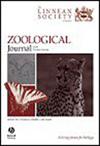Using computed tomography scanning in exceptionally preserved Lower Cretaceous ostracods from Brazil to reassess the evolutionary history of Paracyprididae (Podocopida: Cypridocopina)
IF 3
2区 生物学
Q1 ZOOLOGY
引用次数: 0
Abstract
Calcareous concretions typical of the Lower Cretaceous Romualdo Formation (late Aptian–Albian of the Santana Group), in the northeastern Brazilian Araripe Basin, occasionally yield exceptionally preserved ostracods with pristine soft parts. These rare specimens allow in-depth studies of ostracod taxonomy and systematics. This is particularly important when dealing with the classification of groups where carapace ornamentation is less common, such as the cypridocopines that have been abundant in continental and transitional environments since Late Jurassic times. Damonella grandiensis is a commonly occurring species in the Romualdo Formation that has long caused taxonomic and systematic arguments due to its mostly featureless carapace—the reason it has been known previously as ‘Ostracode n.º 207’. New detailed CT scans of Damonella grandiensis specimens, coupled with scanning electron microscopy and improved stereoscopic micrographs of additional specimens, allow a review of the species, including first descriptions of their caudal rami and paired sperm pumps (Zenker organs). These indicate not only that Damonella grandiensis must be placed within the genus Reconcavona (as Reconcavona grandiensis comb. nov.), but also that this genus is not representative of the Candonidae, but instead of the Paracyprididae—which impacts on the early evolutionary history of paracypridids.利用计算机断层扫描对保存完好的巴西下白垩世介形虫进行重新评估
在巴西Araripe盆地东北部,典型的下白垩世Romualdo组(Santana组的Aptian-Albian晚期)的钙质结块偶尔会产生保存完好的介形虫,这些介形虫具有原始的柔软部分。这些罕见的标本为介形虫分类学和系统学的深入研究提供了条件。当处理甲壳装饰不太常见的类群分类时,这一点尤为重要,比如自晚侏罗世以来在大陆和过渡环境中大量存在的塞浦路斯类。Damonella grande是Romualdo组中常见的一种,由于其几乎没有特征的甲壳,长期以来一直引起分类学和系统上的争论,这就是它以前被称为“207º介形虫”的原因。新的详细的大蒙蝶标本的CT扫描,加上扫描电子显微镜和改进的立体显微照片的额外标本,允许对物种进行审查,包括它们的尾支和成对的精子泵(Zenker器官)的首次描述。这些不仅表明大蒙草必须归入大蒙草属(即大蒙草属)。11),但也表明该属不是假假蝇科的代表,而是影响副假蝇科早期进化史的副假蝇科的代表。
本文章由计算机程序翻译,如有差异,请以英文原文为准。
求助全文
约1分钟内获得全文
求助全文
来源期刊
CiteScore
6.50
自引率
10.70%
发文量
116
审稿时长
6-12 weeks
期刊介绍:
The Zoological Journal of the Linnean Society publishes papers on systematic and evolutionary zoology and comparative, functional and other studies where relevant to these areas. Studies of extinct as well as living animals are included. Reviews are also published; these may be invited by the Editorial Board, but uninvited reviews may also be considered. The Zoological Journal also has a wide circulation amongst zoologists and although narrowly specialized papers are not excluded, potential authors should bear that readership in mind.

 求助内容:
求助内容: 应助结果提醒方式:
应助结果提醒方式:


